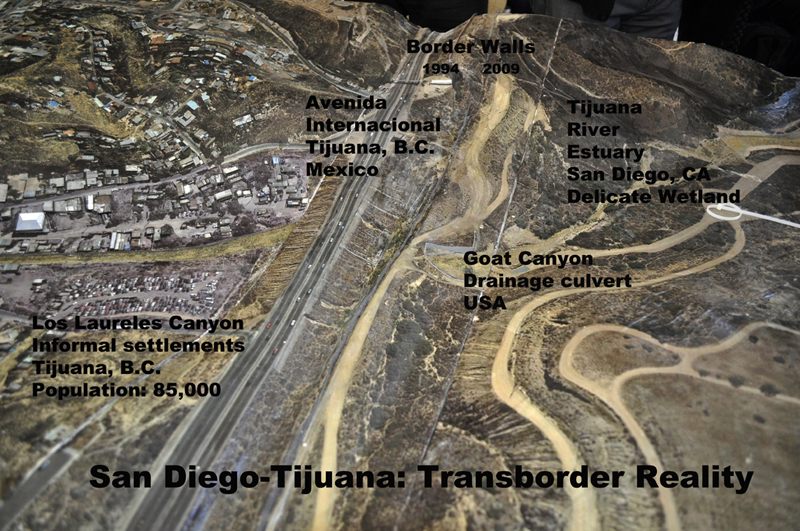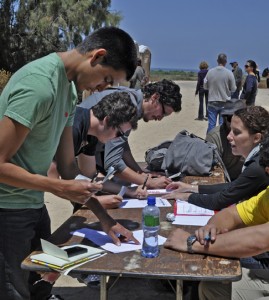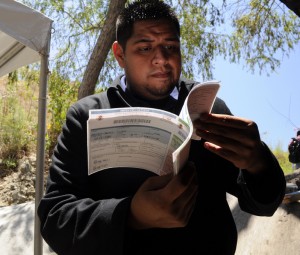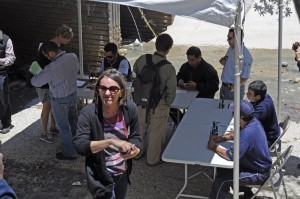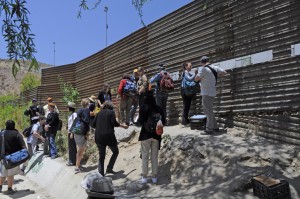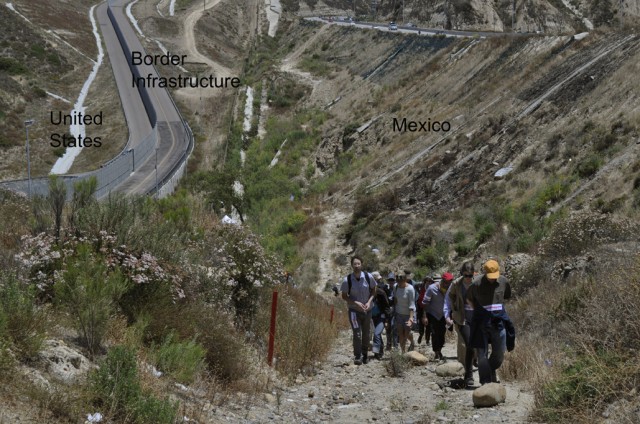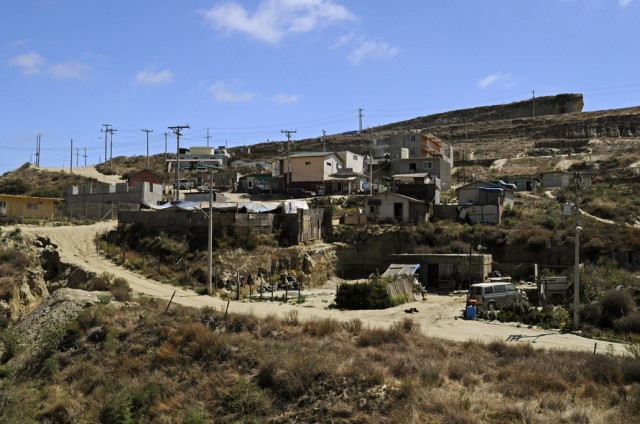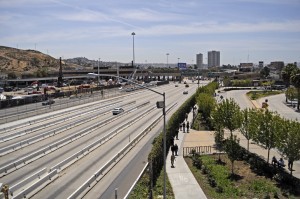Feature story
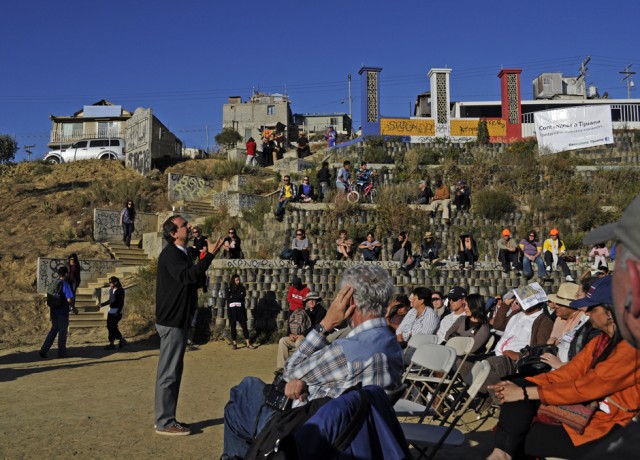
Colonia San Bernardo, informal settlement in Los Laureles Canyon in southwestern Tijuana and site of international conference Political Equator 3
The Logic of the Culvert: Rethinking the San Diego-Tijuana borderlands
by Jill Holslin
“A community is always in dialogue with its immediate social and ecological environment; this is what defines its political nature. But when this relationship is disrupted and its productive capacity splintered by the very way in which jurisdictional power is instituted, it is necessary to find a means of re-cuperating its agency” (Political Equator 3).
If we can say that cities talk, then it seems that San Diego talks mostly to itself.
And we might ask how much longer San Diego will be able to sustain its dialogue with the mythological self it has created, with its orderly gated communities, its pristine ribbons of asphalt sparkling under the perfect sun, and its anxious disavowal of one of its most valuable constitutive features. San Diego is a border city. But it doesn’t want to act like one.
This past weekend, June 3 & 4, 2011, I attended an international conference called Political Equator 3 which posed these difficult questions of identity. But they upped the ante. Billed as “conversations on co-existence,” the gathering provided a forum to include San Diego’s often silenced and invisible other half: we visited some of the immigrant communities in the dynamic borderlands of San Diego-Tijuana.
The third in a series of bi-national conferences begun in San Diego in 2006, this year’s conference put the Tijuana River estuary at the center of a bi-national San Diego-Tijuana map.
Re-centering San Diego as a transborder community made it possible to explore the way political and social relationships are shaped by the contradictions of our transborder region—both sliced through and linked together by the international boundary. Organizers Oscar Romo, Watershed Coordinator for the Tijuana River National Estuarine Research Reserve and Teddy Cruz, UCSD professor of public culture and urbanism staged the conference through public walking tours enabling conversations to unfold through what they called “nomadic routes.”
For two days, we walked around local border sites like the neighborhood of San Ysidro, California, the concrete jungle that is our Port of Entry, the delicate wetland environment of the Tijuana estuary, and colonia San Bernardo in Tijuana’s Los Laureles Canyon. What emerged were powerful insights about the many ways the built environment can fragment nature and disrupt the logic of natural systems like wetlands and watersheds, but also lend itself to the creation of new pathways for social and political development.
We followed a key nomadic route early Saturday afternoon when organizers staged a public border crossing as a performance.
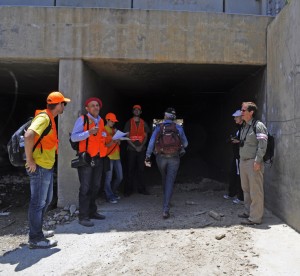
Conference organizer and "coyote" Oscar Romo, directing participants through the culvert at Goat Canyon
Eighty international migrant academics crossed in the forbidden zone between official ports of entry. Walking through a drainage culvert at Goat Canyon on the U.S. side–turned informal Port of Entry for two hours– we were greeted by Mexican border officials who issued travel visas and stamped passports before visitors were allowed to pass along to Los Laureles Canyon on the Mexican side.
Framed as one of many “provocations,” this particular border crossing illustrated how sites of conflict can be transformed into spaces of intervention and change.
This photo essay documents our crossing that day, a journey which revealed to us the mostly invisible mechanisms of the nation-state regulatory regime, but also made visible the many pathways that link communities in San Diego and Tijuana in a network of social, political and ecological interdependence.
From the start, we faced the machinery of a state apparatus controlling the movement of people. Event organizers negotiated with both U.S. Border Patrol and Mexican border authorities for over six months to obtain permission to cross at the informal site of Goat Canyon, yet the status of the permissions kept changing all morning, and changed again just minutes before our crossing–scheduled for 12:30 PM.
The un-predocumented –those who had not RSVP’d to conference organizers by May 25–were granted permission to cross at 9:40 AM, then stood in line in the hot sun to show passports and register, and at the last minute were denied permission to cross just a few hours later after Mexican authorities called Mexico City to confirm.
Meanwhile predocumented participants were prepared with an arsenal of identification documents. Each visitor was required to carry a passport, afix a bumper sticker-sized red & white “Political Equator” tag to their clothing, sign a waiver form on the U.S. side, sign a Mexican travel visa and have their passport stamped at the informal Port of Entry on the south side of the culvert. Under the watchful eye of four U.S. Border Patrol agents stationed on the ridge up above, crossers lined up alphabetically, and each passed through the culvert to receive the travel visa when his or her name was called out.
Considering the trouble we went through to accomplish this crossing, it is worth asking–what was the point? We could easily have crossed at the San Ysidro Port of Entry like everybody else. Were we just a bunch of spoiled, attention-seeking academic tourists out for another exotic experience to write home about?
Trudging through the filthy culvert, I watched as my feet sank into dense sediment, saturated with the waste water, detergent, and trash flowing from the colonias in Tijuana we would be visiting later that day. As we emerged a few minutes later in Mexico, we gathered together briefly at the border wall to get our bearings and then began the hike up a rocky trail to the mesa above where our colleagues had gathered.
Los Laureles Canyon embraces a population of 85,000 migrants from Guatemala, El Salvador, Honduras and southern Mexico. The squatter communities built of garage doors, plastic sheeting, concrete and discarded planks of wood are a testament to human ingenuity and the will to seek a better life.
When you enter Mexico at the San Ysidro Port of Entry, you are confronted with a labyrinth of concrete roads, criss-crossing pedestrian bridges, and aqueducts, a virtual wall of concrete separating the San Diego from Tijuana. The built environment here disrupts the natural pathways that remind us that our region is a singular whole. Like the border wall, the Port of Entry naturalizes the political logics of nation-state and citizenship. And the comforting amenities of neat, clean asphalt, carefully manicured grass and native plants turn an image of state violence into one of security.
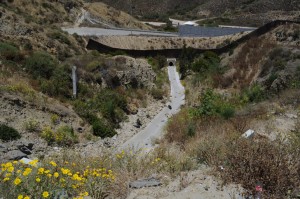
Storm drain carrying rainwater, trash, pollution and sediment from Los Laureles Canyon northward into the Tijuana Estuary
It was clear from here that the structures built to preserve our nation were doing nothing to stop the flow of trash and pollutants coming from informal settlements in Tijuana. But the heavy machinery of the nation-state regulatory system was much more effective in disrupting the natural flows of knowledge and cooperation that will support sustainability in our region.
As the world melts around us and we watch the disintegration of national boundaries and associations that shape our very sense of being and belonging, the most affluent and privileged among us react—sometimes violently—by trying to hang on to what we have. Border walls and concrete separation barriers are a response to this fear.
********************************

